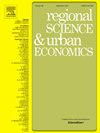煤炭萧条与城市复苏:来自中国的证据
IF 3.5
2区 经济学
Q1 ECONOMICS
引用次数: 0
摘要
在本文中,我们研究了煤炭萧条对城市增长的影响。使用差异分析框架,我们发现中国2012-2015年的煤炭危机显著降低了当地GDP的增长率,尤其是在远离海岸或海港的产煤城市。这种负增长效应在煤炭价格回升一年后有所减少,但这种效应的程度仍然相对持久。进一步分析的结果表明,区域经济体主要通过城市就业的减少和地理位置不利的小型企业的退出来适应不利冲击,因为萧条期间工资的下降不足以吸引企业和资本的流入。本文章由计算机程序翻译,如有差异,请以英文原文为准。
Coal busts and urban recovery: Evidence from China
In this paper, we investigate the effects of a coal bust on urban growth. Using a difference-in-differences framework, we find that China's 2012–2015 coal bust significantly reduced the growth rate of local GDP, especially in coal producing cities located far from the coast or seaports. This negative growth effect decreased one year after coal prices had recovered, but the level of the effect remained relatively persistent. The results of further analysis show that regional economies adjust to adverse shocks primarily through a reduction in urban employment and the exit of small and geographically disadvantaged firms, as the decrease in wages during a bust is insufficient to attract an inflow of firms and capital.
求助全文
通过发布文献求助,成功后即可免费获取论文全文。
去求助
来源期刊

Regional Science and Urban Economics
Multiple-
CiteScore
5.30
自引率
9.70%
发文量
63
期刊介绍:
Regional Science and Urban Economics facilitates and encourages high-quality scholarship on important issues in regional and urban economics. It publishes significant contributions that are theoretical or empirical, positive or normative. It solicits original papers with a spatial dimension that can be of interest to economists. Empirical papers studying causal mechanisms are expected to propose a convincing identification strategy.
 求助内容:
求助内容: 应助结果提醒方式:
应助结果提醒方式:


